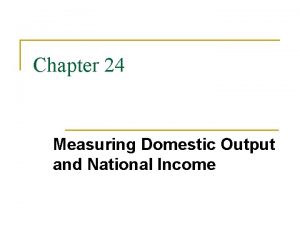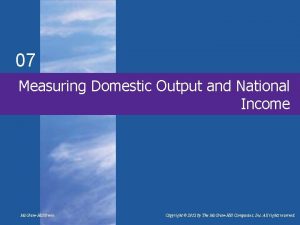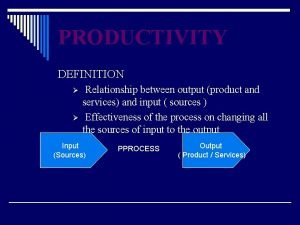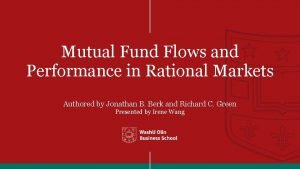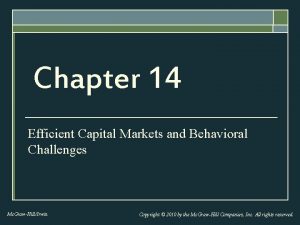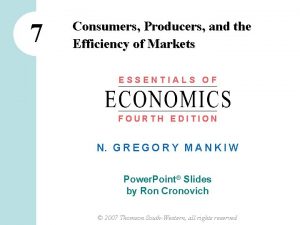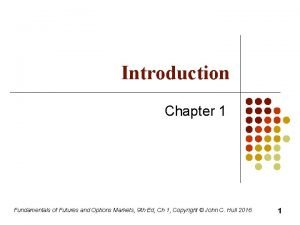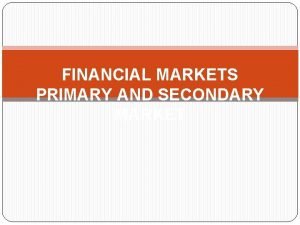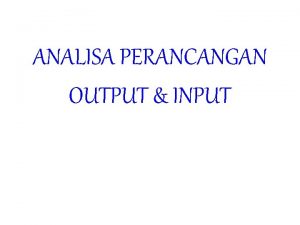Product Markets and National Output Chapter 12 Discussion
































































- Slides: 64

Product Markets and National Output Chapter 12

Discussion Topics üCircular flow of payments üComposition and measurement of gross domestic product üConsumption, saving and investment üEquilibrium national income and output

Partial vs General Equilibrium ü Discussion of market outcomes in the preceding chapters was conducted within a partial equilibrium framework ü Partial Equilibrium – focus on a single market, assuming everything else remains constant ü General Equilibrium – focus on all markets in the economy; all markets are interdependent ü Objectives of Chapter ü Illustrate how businesses and households are linked through resource and product markets ü Discuss the composition and measurement of national output

Circular Flow Diagram for the General Economy

We can measure macroeconomic activity in either resource markets or product markets. Page 224

Four major sectors in the U. S. economy… Page 224

Businesses are net borrowers in financial markets while households are net savers… Page 224

Government receives net inflows of taxes from businesses and households and is a net borrower in financial markets… Page 224

Businesses make investment expenditures, Governments make expenditures, and Households make consumption expenditures Page 224

Businesses receive funds from total expenditures in product markets while households, who own businesses, receive wages, rents, interest and business in resource markets profits where they provide labor and capital services… Page 224

Measurement of Gross Domestic Product

GDP


Gross Domestic Product B. Measurement Money – a common denominator ; add up the value of money in terms of the total output of goods and services during a certain time period, normally a year.







Everything below zero represents a recession Page 227





What’s in GDP? Focus is on new goods and services produced in current year

Types of consumer expenditures… Page 226

Types of investment expenditures… Page 226

Calculation of net exports… Page 226

Types of government Expenditures… Page 226

Items not included in GDP… Page 226

Understanding the Domestic Determinants of GDP C, I, G

Planned Consumption Function The slope of the consumption function is the marginal propensity to consume (MPC), or C÷ YD where YD represents disposable income. Autonomous or fixed consumption Page 228

Planned Consumption Function The consumption function in this graph can be expressed graphically as shown below. C = AC + MPC(DPI) Page 228

Planned Consumption Function Consumer expenditures would be $3, 600 if disposable income was equal to $3, 000. Consumers would be dis-saving by $600. C = $1, 500 +. 70($3, 000) = $3, 600 Page 228

Planned Consumption Function An increase in disposable income to $4, 000 would raise expenditures to $4, 300. Dis-saving would fall to $300. C = $1, 500 +. 70($4, 000) = $4, 300 Page 228

Planned Consumption Function An increase in disposable income to $5, 000 would raise expenditures to $5, 000. Dis-saving would fall to zero. C = $1, 500 +. 70($5, 000) = $5, 000 Page 228

Savings vs. Consumption We said that the slope of the consumption function was the marginal propensity to consume, or: MPC = C ÷ DPI Savings is defined as S = DPI – C And, therefore, the marginal propensity to save is MPS = 1. 0 – MPC Page 228 and 229

Planned Consumption Function A role for fiscal policy here: A cut in the tax rate increases consumption. An increase in the tax rate decreases consumption. Page 228

Planned Consumption Function A role for fiscal policy here: A cut in the tax rate increases consumption. An increase in the tax rate decreases consumption. Page 228

Shifts in Consumption Function • Changes in the level of income correspond to movements along the consumption function • Factors that can shift the consumption function: – Increase/decrease in wealth of nation’s household sector – Expectations of higher income in the near future

Planned Investment Function Level of autonomous investment spending I = AI – MIS(i) Page 233

Planned Investment Function The slope of the investment function is the marginal interest sensitivity of investment or: MIS = I÷ i I = AI – MIS(i) Page 233

Planned Investment Function Level of investment expenditures would be $250 at an interest rate of 9 percent if MIS = 25. I = $475 – 25(9. 0) Page 233

Planned Investment Function Should interest rates fall to 7% as a result of events in the money market, investment expenditures would increase from $250 to $300. I = $475 – 25(7. 0) Page 233

Shifts in Investment Function • Profit expectations • Prices of new investment goods • Technological change • Taxes

Effects of Profit Expectations An increase in profit expectations would shift the investment function to the right (e. g. , would cause businesses to expand their planned investment expenditures by $50 at the same interest rate). I = $525 – 25(7. 0) Page 234

Understanding Product Market Equilibrium

Aggregate Expenditures= C+I+G Consumption expenditures function: C = $1, 500+0. 70(DPI) Page 235

Aggregate Expenditures Consumption expenditures function: C = $1, 500+0. 70(DPI) Investment expenditures function: I = $475 – 25(i) Page 235

Aggregate Expenditures Consumption expenditures function: C = $1, 500+0. 70(DPI) Investment expenditures function: I = $475 – 25(i) Government expenditures function: G = $880 Page 235

Aggregate Expenditures (AE) Consumption expenditures function: C = $1, 500+0. 70(DPI) Investment expenditures function: I = $475 – 25(i) Government expenditures function: G = $880 If the interest rate (i) is equal to 7%, then AE = $1, 500 + 0. 70(DPI) + $475 – 25(7) +$880 = $2, 680 + 0. 70(DPI) Page 235

Aggregate Expenditures Aggregate expenditures equation: AE = $2, 680+0. 70(NI-Tax) Page 235

Aggregate Expenditures Aggregate expenditures equation: AE = $2, 680+0. 70(NI-Tax) where national output equals national income (NI) and Tax is based upon last year’s income (Tax = $400). Page 235

Aggregate Expenditures Aggregate expenditures equation: AE = $2, 680+0. 70(NI-Tax) where national output equals national income (NI) and Tax is based upon last year’s income (Tax = $400). If national income is $6, 000, then AE = $2, 680+0. 70($6, 000 - $400) = $6, 600 which represents the first line in Table 12. 4 Page 235

Aggregate Expenditures Aggregate expenditures equation: AE = $2, 680+0. 70(NI-Tax) where national output equals national income (NI) and Tax is based upon last year’s income (Tax = $400). If national income is $6, 000, then AE = $2, 680+0. 70($6, 000 - $400) = $6, 600 which represents the first line in Table 12. 4 Repeating this for other levels of income gives us the graph on page 236

Aggregate Expenditures Curve Total autonomous domestic spending… Page 236

Aggregate Expenditures Curve Point where spending equals output Y=C+I+G. This equilibrium assumes a given market interest rate and general price level. Note: below this equilibrium, AE>Y which should draw down unsold inventories and increase pressures to expand Y. Page 236

Deriving the Aggregate Demand Curve Aggregate demand curve Demand equals supply Corresponding price level Page 237

Aggregate Supply Curve: represents the nation’s output supplied to consumers, businesses, governments, foreign countries Three distinct ranges of the aggregate supply curve Page 238

Aggregate Supply Curve Maximum potential output in the short run: economy reaches capacity to supply goods and services in current period End of depression or Keynesian range: increases in demand supply unaccompanied by rising prices Page 238

Product Market Equilibrium YFE represents full employment output: economy’s max non-inflationary or natural rate of employment YE represents current or actual output (planned spending) YPOT represents potential or maximum output Page 238

Product Market Equilibrium : theoretical goal is to eliminate inflationary or recessionary gaps YE > YFE > YE Planned spending exceeds full employment output, causing higher inflationary pressures in economy. Planned spending less than full employment output, causing underutilization of economy’s resources. Page 238

Summary ü GDP consists of C, I, G and (X-M) ü Focus is on new goods produced and services performed in the current year ü Consumption influenced by disposable income and wealth ü Investment influenced by interest rates and profit expectations ü Product market equilibrium occurs where aggregate demand equals aggregate supply ü Inflationary and recessionary gaps occur
 Domestic product and national product
Domestic product and national product Quantity supplied vs supply
Quantity supplied vs supply Introduction of simple distillation
Introduction of simple distillation Why study financial markets and institutions?
Why study financial markets and institutions? Black box model consumer behaviour
Black box model consumer behaviour Chapter 9 expanding markets and moving west
Chapter 9 expanding markets and moving west Buyer influences in business markets
Buyer influences in business markets Chapter 5 consumer markets and buyer behavior
Chapter 5 consumer markets and buyer behavior Chapter 5 consumer markets and buyer behavior
Chapter 5 consumer markets and buyer behavior Chapter 9 expanding markets and moving west
Chapter 9 expanding markets and moving west Chapter 9 expanding markets and moving west
Chapter 9 expanding markets and moving west Chapter 7 consumers producers and the efficiency of markets
Chapter 7 consumers producers and the efficiency of markets Measuring domestic output and national income
Measuring domestic output and national income Measuring domestic output and national income
Measuring domestic output and national income Measuring domestic output and national income
Measuring domestic output and national income Measuring domestic output and national income
Measuring domestic output and national income Product life cycle kotler
Product life cycle kotler Central idea of the production
Central idea of the production Product mix and product line
Product mix and product line First screen feasibility analysis
First screen feasibility analysis Cultural dynamics in assessing global markets
Cultural dynamics in assessing global markets Analyzing business markets
Analyzing business markets Chapter 18 the markets for the factors of production
Chapter 18 the markets for the factors of production Analyzing consumer markets
Analyzing consumer markets Firms in competitive markets chapter 14 ppt
Firms in competitive markets chapter 14 ppt National income and product accounts
National income and product accounts Production and productivity definition
Production and productivity definition National unification and the national state
National unification and the national state What is national output
What is national output Chapter 4 night discussion questions
Chapter 4 night discussion questions Chapter 4 findings and discussion
Chapter 4 findings and discussion Contoh joint product
Contoh joint product Core augmented and actual product
Core augmented and actual product Outer product cross product
Outer product cross product Product line depth
Product line depth Sifat perkalian silang vektor
Sifat perkalian silang vektor Core product augmented product
Core product augmented product Product portfolio mix
Product portfolio mix Perkalian silang
Perkalian silang Gdp meaning in economics
Gdp meaning in economics Centrality ap human geography
Centrality ap human geography Tatlong paraan ng national income accounting
Tatlong paraan ng national income accounting Financial intermediation ppt
Financial intermediation ppt Consumers, producers, and the efficiency of markets
Consumers, producers, and the efficiency of markets Historic tax credit structure diagram
Historic tax credit structure diagram Business buyer behaviour
Business buyer behaviour Markets and competitive space
Markets and competitive space Financial markets and institutions ppt
Financial markets and institutions ppt Urban economics and real estate markets
Urban economics and real estate markets Dartmouth sociology
Dartmouth sociology Mutual fund flows and performance in rational markets
Mutual fund flows and performance in rational markets The financial system
The financial system Organizational buyer
Organizational buyer Target market and channel design strategy
Target market and channel design strategy International financial markets and instruments
International financial markets and instruments Efficient capital markets and behavioral challenges
Efficient capital markets and behavioral challenges Consumers producers and the efficiency of markets
Consumers producers and the efficiency of markets Pave smart
Pave smart Savers and investors role in financial markets
Savers and investors role in financial markets Introduction to futures and options
Introduction to futures and options Primary and secondary financial markets
Primary and secondary financial markets Financial markets and the allocation of capital
Financial markets and the allocation of capital Digital market and digital goods
Digital market and digital goods Types of exchange rate
Types of exchange rate Equity markets and stock valuation
Equity markets and stock valuation












